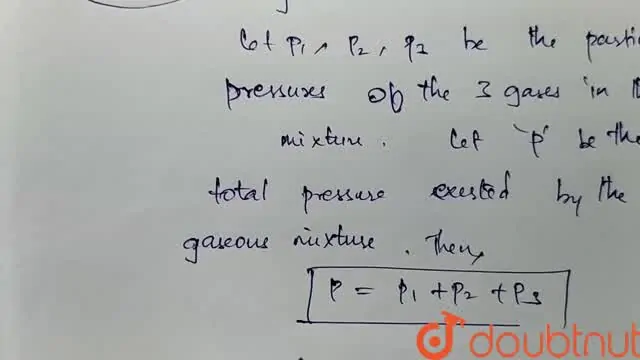State and explain Dalton's law of partial pressures.Solution in Telugu
Dalton.s law of Partial pressures : The total pressure exerted by a mixture of chemically non reacting gases at given temperature and volume, is equal to the sum of the partial pressures of the component gases.
Explanation: Consider a mixture of three gases in a vessel. Let , be the partial pressures of the three gases in the mixture. According to Dalton.s law of partial pressures, the pressure (P) of the gaseous mixture is at the same temperature.
Let , be the number of moles of three gases respectively in the mixture. Let "V be the volume of the mixture of gases at T K temperature
According to ideal gas equation,
Total pressure of the mixture
since
Where is the mole fraction of the first gas and given by
In a similar way .
Partial pressure = mole fraction total pressure
Related Playlists
- BOOK - VIKRAM PUBLICATION ( ANDHRA PUBLICATION)CHAPTER - STATES OF MATTER GASES AND LIQUIDS EXERCISE - LONG ANSWER QUESTIONS22videos
STATES OF MATTER GASES AND LIQUIDS
- BOOK - VIKRAM PUBLICATION ( ANDHRA PUBLICATION)CHAPTER - STATES OF MATTER GASES AND LIQUIDS EXERCISE - VERY SHORT ANSWER QUESTIONS90videos
STATES OF MATTER GASES AND LIQUIDS
- BOOK - VIKRAM PUBLICATION ( ANDHRA PUBLICATION)CHAPTER - ORGANIC CHEMISTRY SOME BASIC PRINCIPLES AND TECHNIQUES EXERCISE - IMPORTANT QUESTIONS42videos
ORGANIC CHEMISTRY SOME BASIC PRINCIPLES AND TECHNIQUES
- BOOK - VIKRAM PUBLICATION ( ANDHRA PUBLICATION)CHAPTER - STOICHIOMETRY EXERCISE - Important Question39videos
STOICHIOMETRY
Similar Questions
Write notes on Intermolecular forces
03:49View SolutionName the different Intermolecular forces experienced by the molecules of a gas.
01:58View SolutionWrite the regents required for conversion of benzene to methyl benzene.
02:37View SolutionHow many number of moles of glucose are present in 540 gms of glucose ?
02:37View SolutionState and explain Dalton's law of partial pressures.
02:14View SolutionState Dalton's law of partial pressures.
02:37View Solutionstate Dalton's law of partial pressure.
08:23View SolutionState Dalton's law of partial pressure.
03:01View SolutionState Dalton's law of Partial Pressure.
04:04View SolutionState Dalton's law of partial pressure,
03:04View SolutionExplain Dalton's law of partial pressures and Charles’ law.
01:58View SolutionState Dalton's law of partial pressure.
03:49View SolutionState Dalton's law of partial pressure.
03:49View SolutionState Dalton's law of partial pressure.
View SolutionState Dalton's law of Partial pressures.
01:58View Solution


